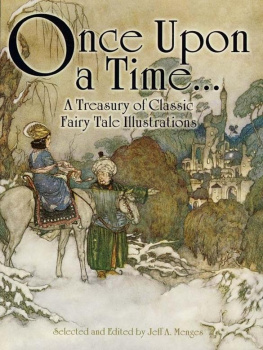NIELSENS
Fairy Tale Illustrations
in Full Color
KAY NIELSEN
DOVER PUBLICATIONS, INC.
Mineola, New York
Copyright Copyright 2006 by Dover Publications, Inc.
All rights reserved.
Bibliographical Note This Dover edition, first published in 2006, is an original compilation of illustrations from the following works:
East of the Sun and West of the Moon: Old Tales from the North, published by G. H. Doran Company, New York, 1922 [all 25 full-color plates; the illustration that faced page 72 now appears on the front cover of the Dover edition, rather than the book interior];
In Powder and Crinoline, published by Hodder & Stoughton, London, 1913 [all 24 full-color plates have been used];
Hansel and Gretel and Other Stories by the Brothers Grimm, published by Hodder & Stoughton, London, 1925 [5 full-color plates have been used]; and
Fairy Tales by Hans Andersen, published by G. H. Doran Company, New York, 1924 [5 full-color plates have been used], A Publishers Note has been prepared specially for the present edition.
Library of Congress Cataloging-in-Publication Data Nielsen, Kay Rasmus. 18861957. Nielsens fairy tale illustrations in full color / Kay Nielsen. p. cm. Compilation of illustrations from four childrens books.
ISBN-13: 978-0-486-44902-9 ISBN-10: 0-486-44902-5 1. Nielsen, Kay Rasmus, 18861957. 2. Fairy talesillustrations. I. II. II.
Title: Fairy tale illustrations in full color.
NC986.5.N53A4 2006 741.64092dc22 2006042307 Manufactured in the United States by Courier Corporation
44902504
www.doverpublications.com PUBLISHERS NOTE Kay Nielsen was one of the most accomplished artists of the Golden Age of childrens book illustration, which spanned the late nineteenth to early twentieth centuries. Illustrations for childrens books were colored by hand in the early 1800s, but by the late nineteenth century, artwork by renowned artists such as Nielsen, Walter Crane, Arthur Rackham, and Edmund Dulac was being reproduced to stunning effect by four-color process book printing. Expensive illustrated gift books were ideal formats for these prolific artists, who frequently turned to the rich world of fairy tales for their subject matter. Kay Nielsen was born in Copenhagen, Denmark, in 1886 to actor parents. Kay (pronounced kye) began drawing as a child and moved to Paris in his late teens to study art.
His watercolors for the gift books In Powder and Crinoline and East of the Sun and West of the Moon were exhibited in 1913 and 1915, respectively, in a London gallery; and his illustrations for The Fairy Tales of Hans Andersen were on view in London in 1924. After a stint designing stage productions for the Danish National Theater, Kay Nielsen married Ulla Pless-Schmidt. In 1936, Nielsen moved to Los Angeles (his wife didnt join him there until the beginning of World War II), where he continued designing for the stage and began working in the movies. Most notably, he helped design the Ave Maria and Night on Bald Mountain sequences for the Walt Disney film Fantasia. During the postwar period, changing tastes and an interest in more realistic artistic expression limited the opportunities for artists such as Nielsen, whose stock-in-trade was fantasy. Thereafter, Nielsen devoted himself to producing murals for local schools in Los Angeles, as well as the Wong Chapel of the First Congregationalist Church; in fact, when he died in 1957, mourners gathered there for his funeral service. The Japanese printmaker Hiroshige (17971858) had a significant impact on Western art and on the work of such illustrators as Nielsen.
This influence is especially noticeable in his stylized treatment of waves as demonstrated by Plates 4, 5, and 42; the bridge scene in Plate 25 also evokes Japanese woodblock prints. Kay Nielsen frequently used intricate patterns to build his characters, as in Plates 7, 12, 17, 18, 19, and 24. The artist often emphasized the costumes at the expense of the storybook characters, mounting tiny, sparingly detailed heads atop voluminous garments. Yet there also are stark, expressive, heroic faces (Plates 2, 9, 12, 28), and romantic intimations (Plates 2, 30, 38, 69). It is also noteworthy that in his later works (the Grimm and Andersen collections), Nielsen abandoned the intricate Beardsley-influenced line rendering in favor of broad, more fleshed-out depictions of characters and their surroundings. H. H.
Doran Company, New York, 1922); all twenty-four plates from In Powder and Crinoline (Hodder & Stoughton, London, 1913); five plates from Hansel and Gretel and Other Stories by the Brothers Grimm (Hodder & Stoughton, London, 1925); and five plates from Fairy Tales by Hans Andersen (G. H. Doran Company, New York, 1924). LIST OF PLATES Front Cover Then he coaxed her down and took her home (The Lassie and Her Godmother [EAST OF THE SUN AND WEST OF THE MOON: OLD TALES FROM THE NORTH, G. H. Doran Company, New York, 1922]) Note: Titles of the books in which the illustration plates originally appeared, as well as plate captions and titles of the stories containing the plates, are given below.
EAST OF THE SUN AND WEST OF THE MOON: OLD TALES FROM THE NORTH
[G. H. Doran Company, New York, 1922] Well, mind and hold tight by my shaggy coat, and then theres nothing to fear, said the Bear, so she rode a long, long way (East of the Sun and West of the Moon) Tell me the way, then, she said, and Ill search you out (East of the Sun and West of the Moon) And then she lay in a little green patch in the midst of the gloomy thick wood (East of the Sun and West of the Moon) The North Wind goes over the sea (East of the Sun and West of the Moon) And flitted away as far as they could from the Castle that lay East of the Sun and West of the Moon (East of the Sun and West of the Moon) The Lad in the Bears skin, and the King of Arabias daughter (The Blue Belt) She saw the Lindworm for the first time as he came in and stood by her side (The Blue Belt) She could not help setting the door a little ajar, just to peep in, whenPop! Out flew the Moon (The Lassie and Her Godmother) He too saw the image in the water; but he looked up at once, and became aware of the lovely Lassie who sate there up in the tree (The Lassie and Her Godmother) Here are your children; now you shall have them again. I am the Virgin Mary (The Lassie and Her Godmother) Youll come to three Princesses, whom you will see standing in the earth up to their necks, with only their heads out (The Three Princesses of Whiteland) So the man gave him a pair of snowshoes (The Three Princesses of Whiteland) The King went into the Castle, and at first his Queen didnt know him, he was so wan and thin, through wandering so far and being so woeful (The Three Princesses of Whiteland) The six brothers riding out to woo (The Giant Who Had No Heart in His Body) On that island stands a church; in that church is a well; in that well swims a duck (The Giant Who Had No Heart in His Body) He took a long, long farewell of the Princess, and when he got out of the Giants door, there stood the Wolf waiting for him (The Giant Who Had No Heart in His Body) When he had walked a day or so, a strange man met him. Whither away? asked the man (The Widows Son) But still the Horse begged him to look behind him (The Widows Son) And this time she whisked off the wig; and there lay the lad, so lovely, and white and red, just as the Princess had seen him in the morning sun (The Widows Son) The Lad in the Battle (The Widows Son) Just as they bent down to take the rose a big dense snowdrift came and carried them away


















 DOVER PUBLICATIONS, INC.
DOVER PUBLICATIONS, INC.